Thunnus
| True tunas | |
|---|---|
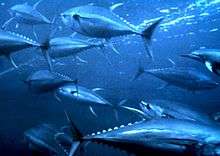 | |
| Yellowfin tuna | |
| Scientific classification | |
| Kingdom: | Animalia |
| Phylum: | Chordata |
| Class: | Actinopterygii |
| Order: | Scombriformes |
| Family: | Scombridae |
| Tribe: | Thunnini |
| Genus: | Thunnus South, 1845 |
| Type species | |
| Scomber thynnus Linnaeus, 1758 | |
| Subgenus | |
| |
| Synonyms | |
| |
Thunnus is a genus of ocean-dwelling, ray-finned bony fish from the Scombridae (mackerel) family. More specifically, Thunnus is one of five genera which make up the Thunnini tribe – a tribe that is collectively known as the tunas. Also called the true tunas or real tunas, Thunnus consists of eight species of tuna (more than half of the overall tribe), divided into two subgenera. The word Thunnus is the Middle Latin form of the Ancient Greek: θύννος, translit. (thýnnos), lit. 'tunny-fish' – which is in turn derived from θύνω (thynō), "to rush; to dart".[3][4] The first written use of the word was by Homer.
Their coloring, metallic blue on top and shimmering silver-white on the bottom, helps camouflage them from above and below. Atlantic bluefin tuna, the largest member of this genus, can grow to 15 feet (4.6 m) long and weigh up to 1,500 pounds (680 kg). All tunas are extremely strong swimmers, and the yellowfin tuna is known to reach speeds of up to 50 miles per hour (80 km/h) when pursuing prey. As with all tunas, members of this genus are warm-blooded, which is a rare trait among fish; this enables them to tolerate cold waters. Bluefin tunas, for example, are found in Newfoundland and Iceland, and also in the tropical waters of the Gulf of Mexico and the Mediterranean Sea, where some individuals go each year to spawn.
Due to overfishing, the range of this genus has declined significantly, having been effectively expirated from the Black Sea, for example.[5]
Taxonomy
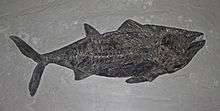
This genus has eight species in two subgenera:
- Subgenus Thunnus (Thunnus):
- Albacore, T. alalunga (Bonnaterre, 1788)
- Southern bluefin tuna, T. maccoyii (Castelnau, 1872)
- Bigeye tuna, T. obesus (Lowe, 1839)
- Pacific bluefin tuna, T. orientalis (Temminck & Schlegel, 1844)
- Atlantic bluefin tuna, T. thynnus (Linnaeus, 1758)
- Subgenus Thunnus (Neothunnus):
- Yellowfin tuna, T. albacares (Bonnaterre, 1788)
- Blackfin tuna, T. atlanticus (Lesson, 1831)
- Longtail tuna, T. tonggol (Bleeker, 1851)

| The True Tunas of the genus Thunnus, within the Family Scombridae | ||||||||||||||||||||||||||||||||||||||||||||||||||||||||||||||||||||||||
|
| ||||||||||||||||||||||||||||||||||||||||||||||||||||||||||||||||||||||||
| Cladogram: Thunnus (bottom-right in image above) is one of five genera that make up the Thunnini tribe. Known as the true tunas, it comprises 8 of the 15 extant tuna species.[1] |
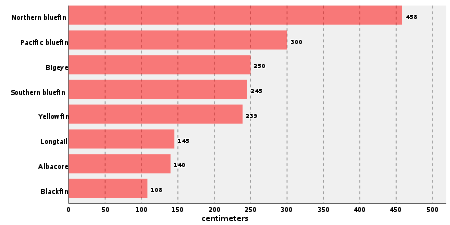
Genus membership
Until recently, seven Thunnus species were thought to exist, and Atlantic bluefin tuna and Pacific bluefin tuna were subspecies of a single species. In 1999, Collette established that based on both molecular and morphological considerations, they are, in fact, distinct species.[6][7]
The genus Thunnus is further classified into two subgenera: Thunnus (Thunnus) (the bluefin group), and Thunnus (Neothunnus) (the yellowfin group).
Thunnus, the true tunas Image Common name Scientific name Maximum
lengthCommon
lengthMaximum
weightMaximum
ageTrophic
levelSource IUCN status Thunnus (Thunnus) – the bluefin group 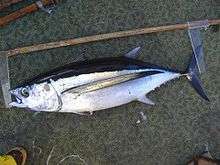
Albacore tuna T. alalunga
(Bonnaterre, 1788)1.4 m
(4.6 ft)1.0 m
(3.3 ft)60.3 kg
(133 lb)9–13 yrs 4.31 [8][9] 
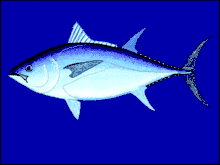
Southern bluefin tuna T. maccoyii
(Castelnau, 1872)2.45 m
(8.0 ft)1.6 m
(5.2 ft)260 kg
(570 lb)20–40 yrs 3.93 [10][11] 
.jpg)
Bigeye tuna T. obesus
(Lowe, 1839)2.5 m
(8.2 ft)1.8 m
(5.9 ft)210 kg
(460 lb)5–16 yrs 4.49 [12][13] 
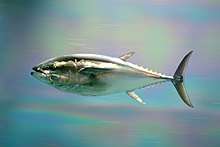
Pacific bluefin tuna T. orientalis
(Temminck & Schlegel, 1844)3.0 m
(9.8 ft)2.0 m
(6.6 ft)450 kg
(990 lb)15–26 yrs 4.21 [14][15] 

Atlantic bluefin tuna T. thynnus
(Linnaeus, 1758)4.6 m
(15 ft)2.0 m
(6.6 ft)684 kg
(1,508 lb)35–50 yrs 4.43 [16][17] 
Thunnus (Neothunnus) – the yellowfin group 
Blackfin tuna T. atlanticus
(Lesson, 1831)1.1 m
(3.6 ft)0.7 m
(2.3 ft)22.4 kg
(49 lb)4.13 [18] 

Longtail tuna,
nothern bluefin tuna,
tongol tunaT. tonggol
(Bleeker, 1851)1.45 m
(4.8 ft)0.7 m
(2.3 ft)35.9 kg
(79 lb)18 years 4.50 [20][21] 

Yellowfin tuna T. albacares
(Bonnaterre, 1788)2.4 m
(7.9 ft)1.5 m
(4.9 ft)200 kg
(440 lb)5–9 yrs 4.34 [22][23] 
Overfishing
The worldwide demand for sushi and sashimi, coupled with increasing population growth, has resulted in global stocks of the species being overfished[24] and bluefin is the most endangered and considered "a serious conservation concern".[25] Complicating the efforts for sustainable management of bluefin fish stocks within national exclusive economic zones (EEZ) is bluefin migrate long distances and hunt in the midocean that is not part of any country's EEZ, so have been vulnerable to overfishing by multiple countries' fishing fleets. International agreements and conventions are good-aith agreements and are difficult to monitor or enforce.[26] Though this fish has been farmed in captivity by the Japanese and by the Australians with the help of the Japanese,[27] yields are lower than other farmed fish due to the slow growth rate of bluefin tuna, therefore keeping prices high.[26] On December 30, 2012, a 222-kilogram (489 lb) bluefin tuna caught off northeastern Japan, was sold at the Tsukiji fish market in Tokyo for a record 155.4 million yen ($1.76 million) – a unit price of JP¥ 1.274 million/kg (US$3,600/lb).[28]
References
- 1 2 Graham, Jeffrey B.; Dickson, Kathryn A. (2004). "Tuna Comparative Physiology" (PDF). The Journal of Experimental Biology. 207: 4015–4024. doi:10.1242/jeb.01267. Retrieved 20 September 2012.
- ↑ Sepkoski, Jack (2002). "A compendium of fossil marine animal genera". Bulletins of American Paleontology. 364: 560. Archived from the original on 2011-07-23. Retrieved 2008-01-08.
- ↑ θύννος in Liddell, Henry George; Scott, Robert (1940) A Greek–English Lexicon, revised and augmented throughout by Jones, Sir Henry Stuart, with the assistance of McKenzie, Roderick. Oxford: Clarendon Press. In the Perseus Digital Library, Tufts University.
- ↑ θύνω in Liddell and Scott.
- ↑ Hogan, C. Michael, Overfishing. Encyclopedia of Earth. eds. Sidney Draggan and Cutler Cleveland. National council for Science and the Environment, Washington DC
- ↑ Collette, B.B. (1999). "Mackerels, molecules, and morphology". In Séret, B.; Sire, J.Y. Proceedings. 5th Indo-Pacific Fish Conference: Nouméa, New Caledonia, 3–8 November 1997. Paris: Société Française d'Ichtyologie [u.a.] pp. 149–164. ISBN 978-2-9507330-5-4.
- ↑ Tanaka, Y.; Satoh, K.; Iwahashi, M.; Yamada, H. (2006). "Growth-dependent recruitment of Pacific bluefin tuna Thunnus orientalis in the northwestern Pacific Ocean" (PDF). Marine Ecology Progress Series. 319: 225–235. doi:10.3354/meps319225. Archived from the original (PDF) on 2012-12-11.
- ↑ Froese, Rainer and Pauly, Daniel, eds. (2012). "Thunnus alalunga" in FishBase. January 2012 version.
- 1 2 Collette B and 35 others (2011). "Thunnus alalunga". IUCN Red List of Threatened Species. Version 2014.3. International Union for Conservation of Nature. Retrieved 9 January 2015.
- ↑ Froese, Rainer and Pauly, Daniel, eds. (2012). "Thunnus maccoyii" in FishBase. January 2012 version.
- 1 2 Collette B and 8 others (2011). "Thunnus maccoyii". IUCN Red List of Threatened Species. Version 2014.3. International Union for Conservation of Nature. Retrieved 9 January 2015. "This species has been intensively fished since the early 1950s. Its generation length is conservatively estimated to be 12 years. Estimated spawning stock biomass has declined approximately 85% over the past 36 years (1973–2009) and there is no sign that the spawning stock is rebuilding. It is therefore listed as Critically Endangered. Implementation of effective conservation and management measures are urgently needed."
- ↑ Froese, Rainer and Pauly, Daniel, eds. (2012). "Thunnus obesus" in FishBase. January 2012 version.
- 1 2 Collette B and 31 others (2011). "Thunnus obesus". IUCN Red List of Threatened Species. Version 2014.3. International Union for Conservation of Nature. Retrieved 9 January 2015.
- ↑ Froese, Rainer and Pauly, Daniel, eds. (2012). "Thunnus orientalis" in FishBase. January 2012 version.
- 1 2 Collette B and 6 others (2014). "Thunnus orientalis". IUCN Red List of Threatened Species. Version 2014.3. International Union for Conservation of Nature. Retrieved 9 January 2015.
- ↑ Froese, Rainer and Pauly, Daniel, eds. (2012). "Thunnus thynnus" in FishBase. January 2012 version.
- 1 2 Collette B and 23 others (2011). "Thunnus thynnus". IUCN Red List of Threatened Species. Version 2014.3. International Union for Conservation of Nature. Retrieved 9 January 2015.
- ↑ Froese, Rainer and Pauly, Daniel, eds. (2012). "Thunnus atlanticus" in FishBase. January 2012 version.
- ↑ Collette B and 18 others (2011). "Thunnus atlanticus". IUCN Red List of Threatened Species. Version 2014.3. International Union for Conservation of Nature. Retrieved 9 January 2015.
- ↑ Froese, Rainer and Pauly, Daniel, eds. (2012). "Thunnus tonggol" in FishBase. January 2012 version.
- 1 2 Collette B and 7 others (2011). "Thunnus tonggol". IUCN Red List of Threatened Species. Version 2014.3. International Union for Conservation of Nature. Retrieved 9 January 2015.
- ↑ Froese, Rainer and Pauly, Daniel, eds. (2012). "Thunnus albacares" in FishBase. January 2012 version.
- 1 2 Collette B and 35 others (2011). "Thunnus albacares". IUCN Red List of Threatened Species. Version 2014.3. International Union for Conservation of Nature. Retrieved 9 January 2015.
- ↑ George Karleskint; Richard Turner; James Small (2009). Introduction to Marine Biology. Cengage Learning. p. 522. ISBN 0-495-56197-5.
- ↑ "Tuna, Bluefin". Archived from the original on 2011-07-22.
- 1 2 "Managed to death". The Economist. 2008-10-30.
- ↑ Thunnus orientalis#Farming
- ↑ "A bluefin tuna sells for record $1.76M in Tokyo". USA Today. 4 January 2013. Retrieved 5 January 2013.
Further reading
- Charles Clover. 2004. The End of the Line: How Overfishing Is Changing the World and What We Eat. Ebury Press, London. ISBN 0-09-189780-7
- Newlands, Nathaniel K.; Molly E. Lutcavage; Tony J. Pitcher (2006). "Atlantic Bluefin Tuna in the Gulf of Maine, I: Estimation of Seasonal Abundance Accounting for Movement, School and School-Aggregation Behaviour". Environmental Biology of Fishes. 77 (2): 177–195. doi:10.1007/s10641-006-9069-5. ISSN 0378-1909.
External links
| Wikimedia Commons has media related to Thunnus. |
- Froese, Rainer, and Daniel Pauly, eds. (2006). Species of Thunnus in FishBase. January 2006 version.
- Nutritional benefits of tuna dead link]
- The International Commission for the Conservation of Atlantic Tunas
